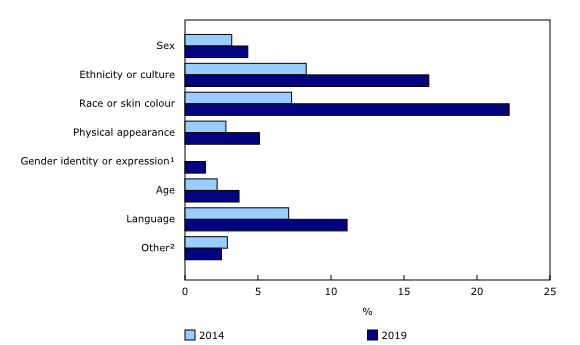We have as a society, mostly been conditioned to believe that discrimination exists against people of colour due to the visibility of Black Lives Matter and other organizations. However, a section of the population that goes unnoticed is the vast Chinese Asian population. Allymonews intends to shed some light on this issue with some data today.

The General Social Survey
In the five years preceding the 2019 General Social Survey (GSS) on Canadians’ Safety (Victimization), 3 in 10 (29%) Chinese people aged 15 and older in Canada reported experiencing discrimination or unfair treatment in their daily lives. While this proportion was similar to that of other racialized populations (29%), it was nearly double that of the non-racialized population (16%).
The proportion of Chinese people who experienced discrimination nearly doubled from 2014 to 2019
Compared with the 2014 GSS on Victimization, the proportion of Chinese people who experienced discrimination in 2019 nearly doubled (16% versus 29%). Increases were also noted among other racialized populations (21% in 2014 versus 29% in 2019) and the non-racialized population (12% versus 16%); however, the rise was more pronounced among Chinese people.
The increase in discrimination experienced by Chinese people from 2014 to 2019 was largely driven by increases in discrimination based on race or skin colour and ethnicity or culture. Discrimination on the basis of language also increased, although to a lesser extent.
A large majority of Chinese people report confidence in the police
A large majority (85%) of Chinese people reported a great deal of or some confidence in the police; however, this was lower than among the non-racialized population (92%). Chinese people said less often that they thought the police do a good job for every measure of police performance included in the survey, compared with other racialized populations and the non-racialized population.
One-quarter (25%) of Chinese people came into contact with police in the 12 months that preceded the GSS on Victimization, for a variety of reasons. The proportion of Chinese people who had contact with police was not significantly different, compared with other racialized populations (30%), but it was lower than the non-racialized population (36%). Of those who had contact with police, three-quarters (75%E) of Chinese people perceived their experience as positive, lower than other racialized populations (87%) and the non-racialized population (89%).

Around one in six Chinese people experienced serious legal problems or disputes in the past three years
According to the Canadian Legal Problems Survey, around one in six (16%) Chinese people experienced a serious legal problem or dispute—such as discrimination, neighbourhood issues, harassment and debt or housing issues—in the three years preceding the survey. Serious problems or disputes were less common for Chinese people than for those from other racialized populations (21%), while there was no difference compared with those from the non-racialized population.
Chinese people who experienced a serious problem most commonly reported dealing with health or social impacts as a result (68%E), while nearly half (45%E) of Chinese people said that the serious legal problem they experienced had financial impacts.
Note to readers
For this analysis, “Chinese people” includes those who self-identified as Chinese when responding to each respective survey. Throughout the article, the experiences and perceptions of Chinese people are compared with those of individuals from other racialized populations (i.e., those who are South Asian, Black, Filipino, Arab, Latin American, Southeast Asian, West Asian, Korean or Japanese; those who identify with multiple racialized groups; and those who identify with a racialized group not elsewhere indicated) and those from the non-racialized population (excludes the Indigenous population [First Nations, Métis and Inuit], but includes the non-Indigenous population).
While the experiences and perspectives of Chinese people living in Canada are grouped for analysis, it is important to note that the Chinese population is diverse and includes individuals with varying backgrounds, circumstances and lived experiences. The same is true for other racialized populations and the non-racialized population, which are the comparison groups in this article. It should also be noted that the findings from the General Social Survey (GSS) in this article generally predate the COVID-19 pandemic. As such, recent experiences and perceptions may have shifted. This is especially true for the Chinese population in Canada, which was targeted during the pandemic.



